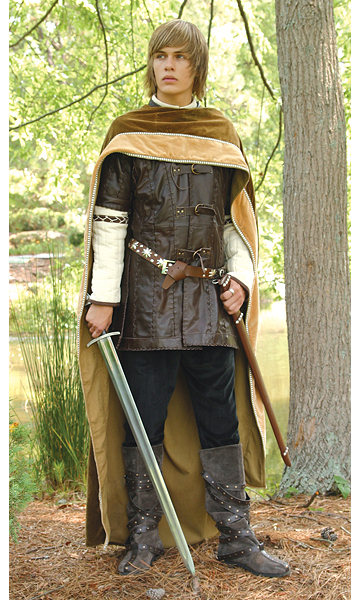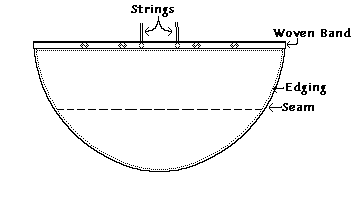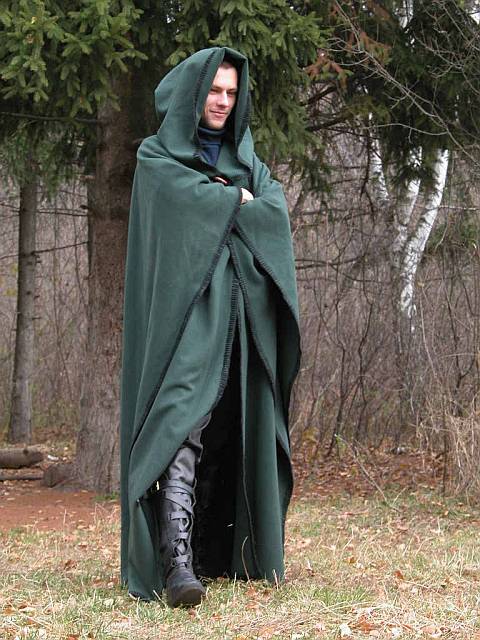Difference between revisions of "Cloak"
Weird Bird (talk | contribs) m (→Links: - Fixed some dead links via the Wayback Machine.) |
Weird Bird (talk | contribs) m (Removed a link to a page on coats that doesn't exist.) |
||
| Line 5: | Line 5: | ||
[[Image:Greatsword 2027 58410046.jpeg|thumb|Example of an Anglo Saxon Cape, in a modern material]] | [[Image:Greatsword 2027 58410046.jpeg|thumb|Example of an Anglo Saxon Cape, in a modern material]] | ||
| − | A [[cloak]] is a type of loose garment that is worn over other clothing and serves the same purpose as a | + | A [[cloak]] is a type of loose garment that is worn over other clothing and serves the same purpose as a coat. It protects the wearer from the cold, rain, or wind, or it might be worn as a fashionable piece of [[garb]]. |
[[Image:SemiCloak1.gif|150px|left|thumb|Historical example of a Viking Semi Circle Cloak]] | [[Image:SemiCloak1.gif|150px|left|thumb|Historical example of a Viking Semi Circle Cloak]] | ||
Latest revision as of 03:50, 10 February 2024
| This article may require cleanup. The specific problem is: some heading incomplete. Relevant discussion may be found on the talk page. Please help improve this article if you can. (April 2016) |
A cloak is a type of loose garment that is worn over other clothing and serves the same purpose as a coat. It protects the wearer from the cold, rain, or wind, or it might be worn as a fashionable piece of garb.
History
A loose type of outer covering for the body has remained in use in all parts of the world since man first wore animal skins. Throughout the centuries the piece of fabric, large or small, was utilized by the ordinary man or woman as a blanket or bed-covering at night and a garment by day, its size and material varying only according to the climate in which it was being worn. Examples of this double use of the cloak stem most often from societies where a person had to spend the night in cold weather or in the open and required protection from the rain and wind. Roman soldiers used their cloaks for this purpose, as did the Scots who wrapped themselves in their plaid at night and pleated and draped it round themselves by day. In the Middle East, the Arab burnous and hayk have traditionally served the same purpose as they were essential in the chill of the desert night. The earliest cloaks were simply fur skins held to the body by a leather thong or fastened by a thorn or a crude pin at the shoulder. Later, the cloak became an outer garment worn over a tunic and hose; while in the more sophisticated times of the sixteenth and seventeenth centuries in Europe, this outer garment, still necessary for travelling, riding and keeping out the cold, had become an item of fashion in its own right, with an elegance of line and beauty of fabric and lining.
Making a cloak
Types of cloaks
Half Circle is literally a partial circle of fabric. This style does not close well in front. For warmth, chose one of the other styles, like a full circle cloak. The basic pattern calls for a large half-circle for the cloak. Instead of cutting a half-circle or oval in the center of the straight side the way you normally would for a cloak, come in 2-3 inches and then cut a full circle 6 or 7 inches in diameter (depending on the size of your head). Then just stick your head through the hole. That has the right drape.
The Rectangle Style has much fabric gathered into the neck. This is the type of cloak is just a rectangle (fingertip to fingertip, and down to the floor on both sides) with a split up the center and a hood. Folkwear Kinsale Cloak - for experienced sewers (this pattern has a number of advanced techniques).
A Pareo is almost the simplest of capes to make. It is a long length of wool fabric about 70 to 80 inches made from 60 inch wide cloth that is slit and very lightly shaped part way up the centre fold.
This is an item that might get an airing once a year or so when you are seeking a cover up for a difficult to cover evening dress to take you from car to door, but when a pashmina is simply too lightweight. It is also perfect for fancy dress to add a touch of mystery. My sister and I have always jokingly referred to pareos as Zorro capes, and they are dramatic when made in black material.
They would also be ideal as fast to make capes for a drama production. This is because the fabric is preserved in almost its whole state, so the item might be re-cut into another garment for another project at a later date.


